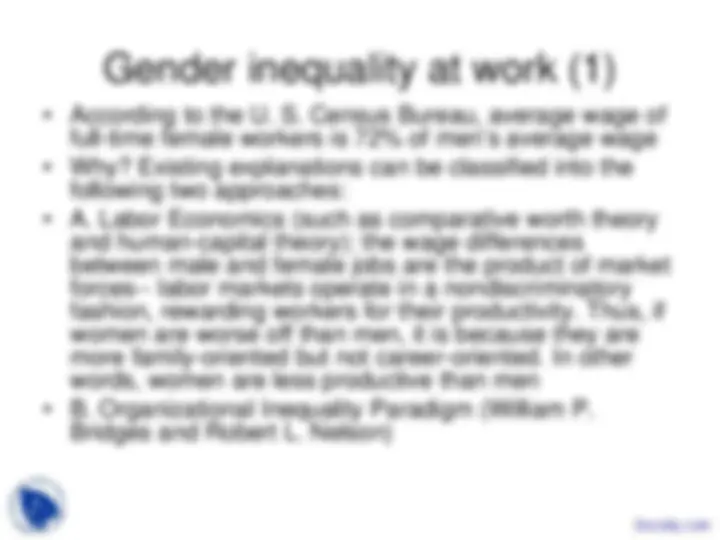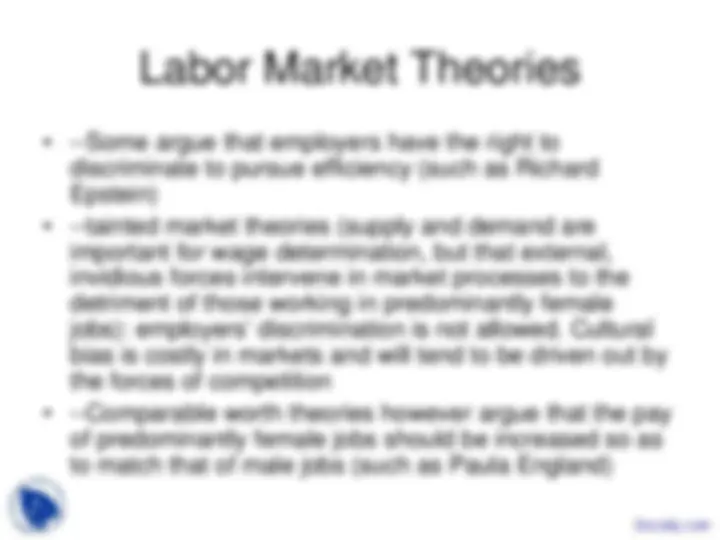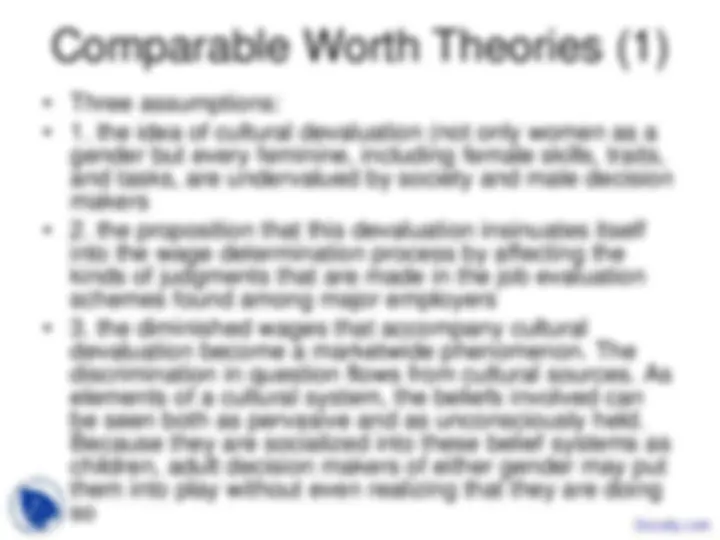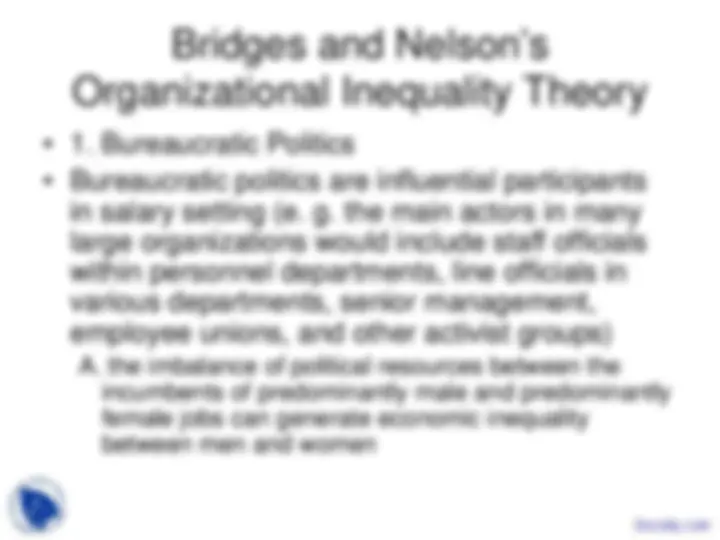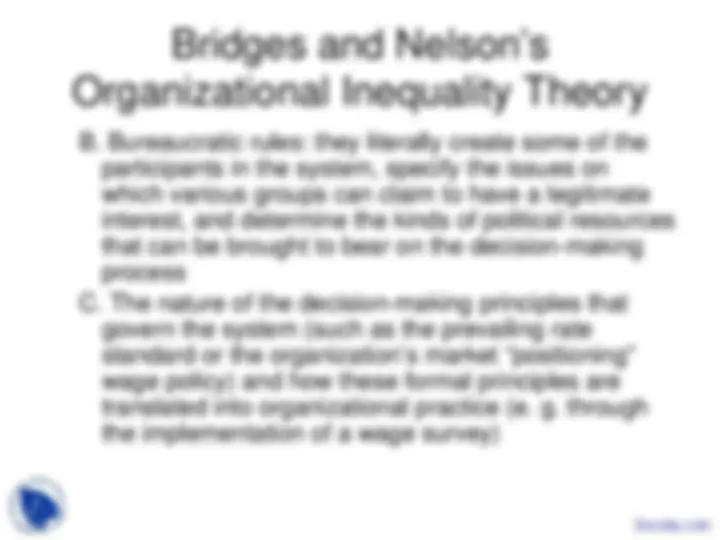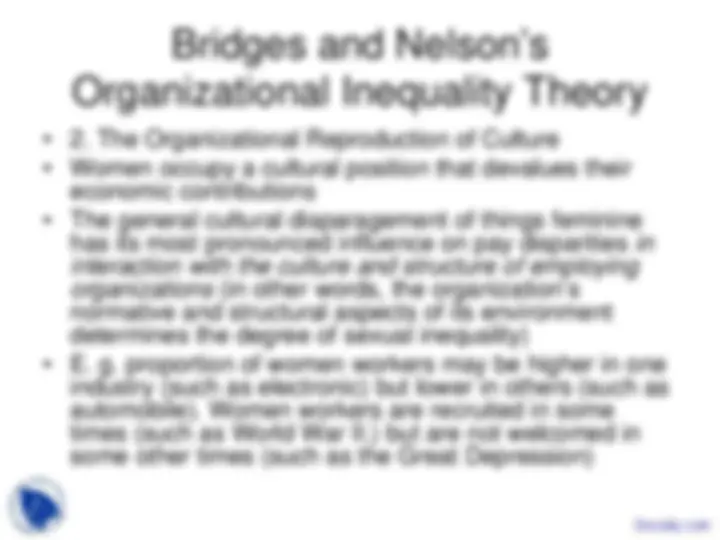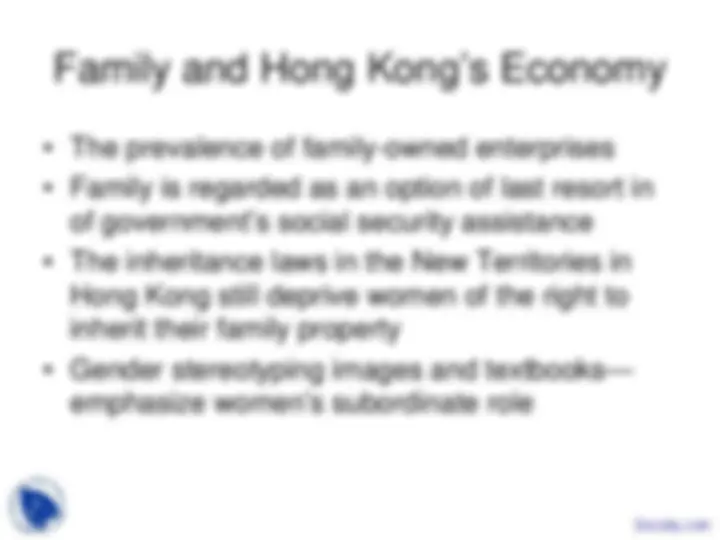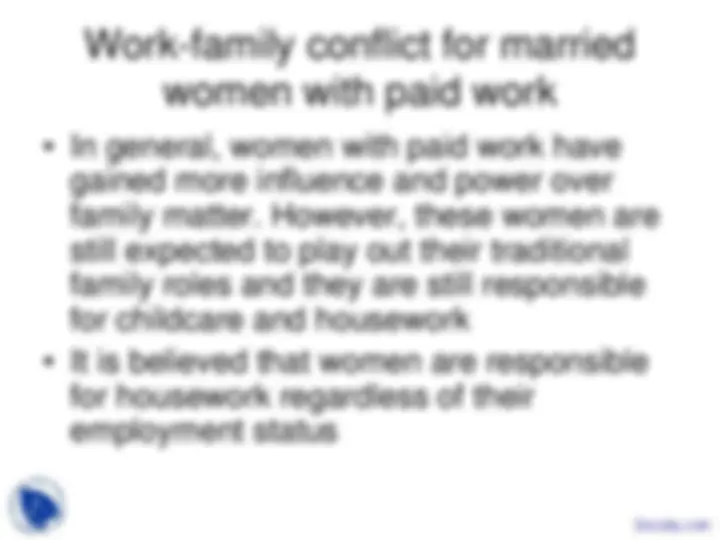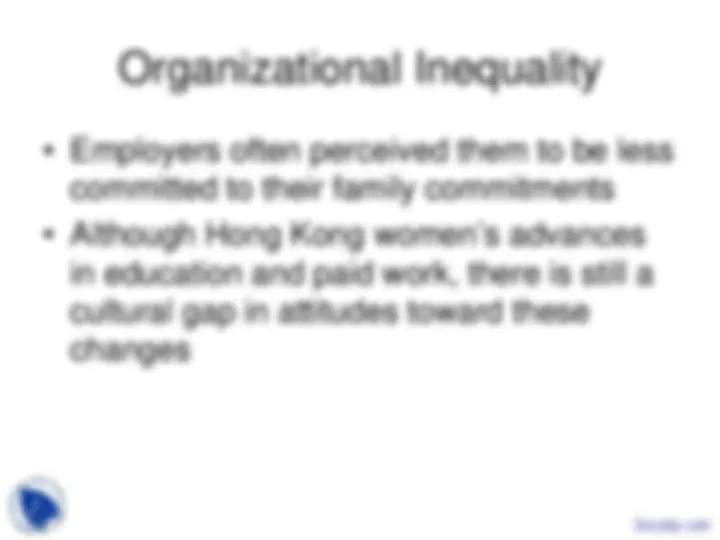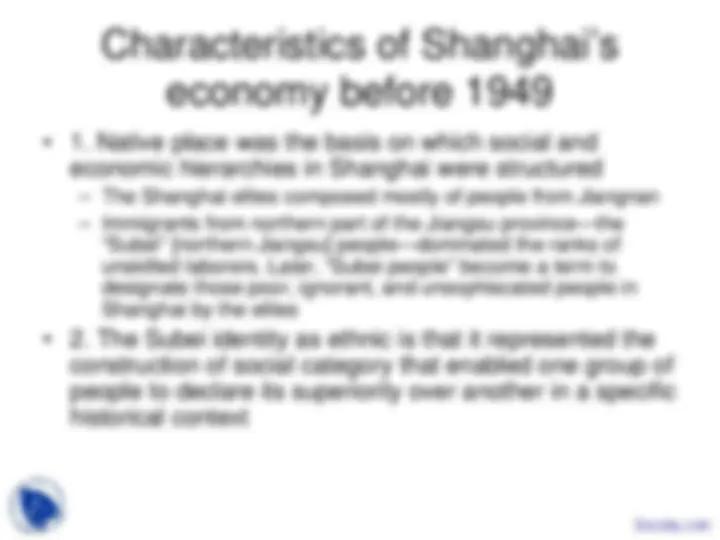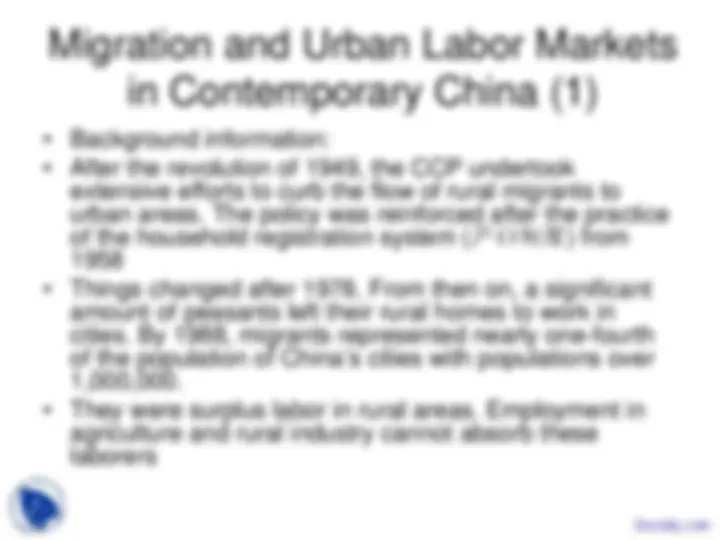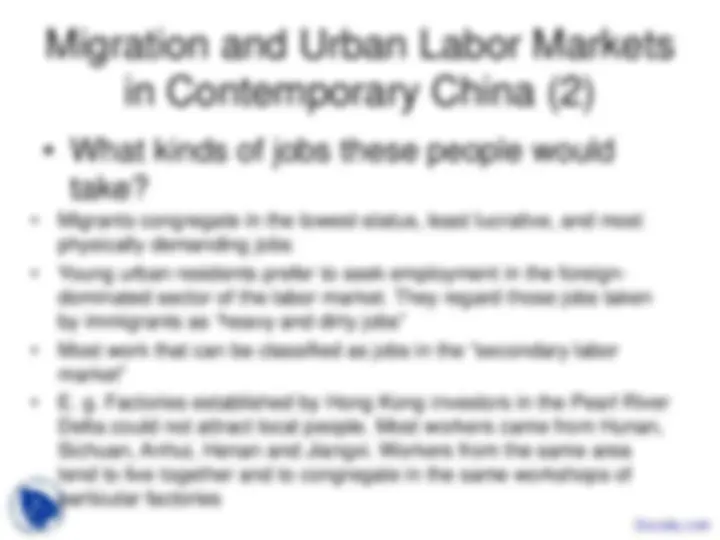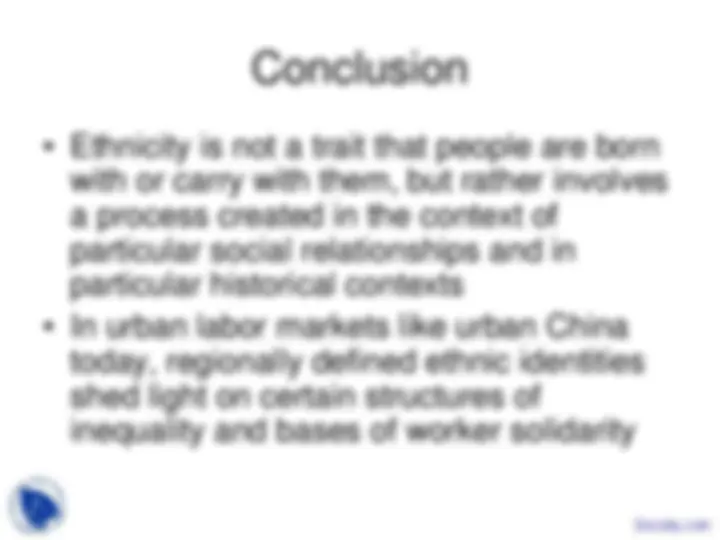Download Gender and Ethnicity in Labor Markets: Inequality and Discrimination and more Slides Economic Sociology in PDF only on Docsity!
Lecture Note 10
Gendered Labor Market
Ethnicized Labor Market
Main Issues
A. Gendered Labor Market
1. Two competing paradigms on gendered
labor market--emphasize the
organizational inequality approach
(Bridges and Nelson’s research)
2. Gender and Work in Hong Kong
B. Ethnicized Labor Market (Emily Honig’s
research on Shanghai)
Labor Market Theories
- --Some argue that employers have the right to
discriminate to pursue efficiency (such as Richard Epstein)
- --tainted market theories (supply and demand are
important for wage determination, but that external, invidious forces intervene in market processes to the detriment of those working in predominantly female jobs): employers’ discrimination is not allowed. Cultural bias is costly in markets and will tend to be driven out by the forces of competition
- --Comparable worth theories however argue that the pay
of predominantly female jobs should be increased so as to match that of male jobs (such as Paula England)
Comparable Worth Theories (1)
- Three assumptions:
- the idea of cultural devaluation (not only women as a gender but every feminine, including female skills, traits, and tasks, are undervalued by society and male decision makers
- the proposition that this devaluation insinuates itself into the wage determination process by affecting the kinds of judgments that are made in the job evaluation schemes found among major employers
- the diminished wages that accompany cultural devaluation become a marketwide phenomenon. The discrimination in question flows from cultural sources. As elements of a cultural system, the beliefs involved can be seen both as pervasive and as unconsciously held. Because they are socialized into these belief systems as children, adult decision makers of either gender may put them into play without even realizing that they are doing so Docsity.com
The Organizational Inequality
Paradigm
- Noneconomic influences on pay levels are
systematically linked to the interests of
organizational constituencies and are
important sources of wage differences
- Bureaucratic Politics
- Organizational Reproduction of Culture
Bridges and Nelson’s
Organizational Inequality Theory
- Bureaucratic Politics
- Bureaucratic politics are influential participants
in salary setting (e. g. the main actors in many
large organizations would include staff officials
within personnel departments, line officials in
various departments, senior management,
employee unions, and other activist groups)
A. the imbalance of political resources between the incumbents of predominantly male and predominantly female jobs can generate economic inequality between men and women
Bridges and Nelson’s
Organizational Inequality Theory
- The Organizational Reproduction of Culture
- Women occupy a cultural position that devalues their economic contributions
- The general cultural disparagement of things feminine has its most pronounced influence on pay disparities in interaction with the culture and structure of employing organizations (in other words, the organization’s normative and structural aspects of its environment determines the degree of sexual inequality)
- E. g. proportion of women workers may be higher in one industry (such as electronic) but lower in others (such as automobile). Women workers are recruited in some times (such as World War II.) but are not welcomed in some other times (such as the Great Depression)
Bridges and Nelson’s
Organizational Inequality Theory
- Internal labor markets are important of how
organizations mediate the effect of labor
markets:
- When workforce is made up of internal labor
market, in which workers are hired for entry-level
positions but then progress up a series of
organization-specific job ladders, many jobs in
the organizations cannot be readily compared
with jobs in the external market. In large
organizations, internal labor markets function to
decouple pay setting from the market
Family and Hong Kong’s Economy
- The prevalence of family-owned enterprises
- Family is regarded as an option of last resort in
of government’s social security assistance
- The inheritance laws in the New Territories in
Hong Kong still deprive women of the right to
inherit their family property
- Gender stereotyping images and textbooks—
emphasize women’s subordinate role
Work-family conflict for married
women with paid work
- In general, women with paid work have
gained more influence and power over
family matter. However, these women are
still expected to play out their traditional
family roles and they are still responsible
for childcare and housework
- It is believed that women are responsible
for housework regardless of their
employment status
Ethnicized Labor Market in China (1)
- Chinese urban history is replete with instances
of labor markets divided by native-place cliques
- The native-place based ethnic identity is not
essential. It labeled only after people from the
same place flock to a new area (mostly a city)
- How the boundary is demarcated? 1. Earlier
arrivals controlled the most lucrative economic
opportunities, they also unified to prevent the
competition for the resources from late comers;
2. “Insider”/”outsider” (or “native”/”immigrant”)
identity and division
Ethnicized Labor Market in China (2)
- Patterns of economic specialization by native place are keys to understand “ethnic division of labor” in urban China in late imperial period till 1949 (W. G. Skinner): see case studies in Beijing (D. Strand), Hankou (W. Rowe), Singapore, Penang and Malacca (Mak Lau Fong), Hong Kong (E. Sinn, C. F. Blake [New Territories], D. W. Sparks [Teochew]) and Taiwan (D. Ownby and S. Harrell, Hill Gates)
- In contemporary China, especially after 1978, first time since the revolution of 1949 that peasants could leave their rural homes to seek jobs in cities—native-place based ethnic status becomes important, once again
Migration and Urban Labor Markets
in Contemporary China (1)
- Background information:
- After the revolution of 1949, the CCP undertook extensive efforts to curb the flow of rural migrants to urban areas. The policy was reinforced after the practice of the household registration system (戶口制度) from 1958
- Things changed after 1978. From then on, a significant amount of peasants left their rural homes to work in cities. By 1988, migrants represented nearly one-fourth of the population of China’s cities with populations over 1,000,000.
- They were surplus labor in rural areas. Employment in agriculture and rural industry cannot absorb these laborers
Migration and Urban Labor Markets
in Contemporary China (2)
- What kinds of jobs these people would
take?
- Migrants congregate in the lowest-status, least lucrative, and most physically demanding jobs
- Young urban residents prefer to seek employment in the foreign- dominated sector of the labor market. They regard those jobs taken by immigrants as “heavy and dirty jobs”
- Most work that can be classified as jobs in the “secondary labor market”
- E. g. Factories established by Hong Kong investors in the Pearl River Delta could not attract local people. Most workers came from Hunan, Sichuan, Anhui, Henan and Jiangxi. Workers from the same area tend to live together and to congregate in the same workshops of particular factories

